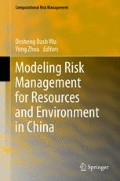Abstract
In Input–output Analysis, consumption coefficients play an important role and reflect the production technology of the economic system. The largest eigenvalue of Leontief matrix has some economic meanings. To some degree, it indicates a limit on economic growth, which means the economic system may grow only when the gross input coefficient is bigger than the largest eigenvalue. On the other hand, it has inverse proportion relation with final demands rate. In an empirical analysis for the five countries, China, Japan, Britain, America and Australia, results are calculated for these countries’ eigenvalues of Leontief matrices. The outcomes exhibit a large degree of stability across the different years’ matrices for a country. Therefore it is confirmed that the largest eigenvalue can reflect a kind of inner regularity. List of these countries according to the average value of largest eigenvalues in a decreasing order are China, Japan, Britain, America and Australia.
Access this chapter
Tax calculation will be finalised at checkout
Purchases are for personal use only
References
Bialas S, Gurgul H (1998) On hypothesis about the second eigenvalue of the Leontief matrix. Econ Syst Res 10(3):285–289
Brody A (1997) The second eigenvalue of the Leontief matrix. Econ Syst Res 9(3):253–258
Hua LG (1984) Optimum mathematical theory in national planed economy. Chinese Sci Bull 29(12):705–709, 29(13):769–772, 29(16):961–963, 29(18):1089–1092, 29(21):1281–1282 (in Chinese)
Hua LG (1985) Optimum mathematical theory in national planed economy. Chinese Sci Bull 30(1):1–2, 30(9):641–645 (in Chinese)
Lancaster P, Tismenetsky M (1985) The theory of matrices with applications, 2nd edn. Academic, New York
Leontief W (1936) Quantitative input-output relations in the economic system of United States. Rev Econ Statistic 18:105–125
Leontief W (1951) The structure of American economy, 1919–1939. Oxford University Press, New York
Leontief W (1953) Studies in the structure of the American economy. Oxford University Press, New York
Rothblum UG (1975) Algebraic Eigen space of nonnegative matrices. Linear Algebra Appl 12:281–292
Xu DJ, Wang WP (2010) Research on application of linear system theory in macroeconomics. In: 8th IEEE International Conference on Control & Automation, China, pp 1843–1847
Xu DJ, Liu Y, Li ZQ, Yu YB, Li AQ (2005) Research on economic growth models in multi-sector macroeconomics. In: Proceedings of the 12th International Conference on Management Science & Engineering, vol 2, pp 1498–1502
Author information
Authors and Affiliations
Corresponding author
Editor information
Editors and Affiliations
Rights and permissions
Copyright information
© 2011 Springer-Verlag Berlin Heidelberg
About this paper
Cite this paper
Xu, D., Yan, S. (2011). Empirical Analysis of Largest Eigenvalue of Leontief Matrix. In: Wu, D., Zhou, Y. (eds) Modeling Risk Management for Resources and Environment in China. Computational Risk Management. Springer, Berlin, Heidelberg. https://doi.org/10.1007/978-3-642-18387-4_44
Download citation
DOI: https://doi.org/10.1007/978-3-642-18387-4_44
Published:
Publisher Name: Springer, Berlin, Heidelberg
Print ISBN: 978-3-642-18386-7
Online ISBN: 978-3-642-18387-4
eBook Packages: Business and EconomicsBusiness and Management (R0)

